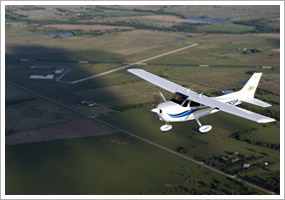| The following stories from the April 17, 2009, edition of AOPA ePilot were provided to AOPA members who expressed an interest in the particular subject areas. Any AOPA member can receive information tailored to their areas of interest by updating their preferences online. - My ePilot -- Turbine Interest -Meridian gets G1000Garmin International on April 16 announced that its G1000 avionics suite is now certified for installation in the Piper Meridian single-engine turboprop. The first G1000-equipped Meridians are expected to be delivered immediately. Read more >> TRAINING TIPsMinimum-altitude aptitude
Rarely is it necessary (or prudent) to fly at minimum altitudes outside the airport environment. But knowing what’s permitted—or isn’t—is every pilot’s obligation. Practicing ground reference maneuvers or simulated engine-out emergency landings could bring about a conflict—or defy local training etiquette—in inappropriate areas. So be sure you can answer questions like those in the AOPA Air Safety Foundation’s Safety Advisor Instructor’s Guide to the Pre-Solo Written Test .
The applicable regulation contains three sections (plus helicopter exceptions):
Straightforward? Not always.
“The FAA does not define congested area in the FARs or in the Aeronautical Information Manual,” Kathy Yodice wrote in her April 2006 AOPA Flight Training column “ Legal Briefing: Minimum safe altitudes.” “Interpretations in low-flight enforcement cases are not consistent for purposes of drafting a precise definition. Such a determination is usually decided on a case-by-case basis, and in the cases that we've seen, ‘congested’ has been interpreted rather broadly. For example, a highway with moderate traffic was found to be ‘congested,’ as was a seaside area where 200 to 300 persons were sitting on the beach or bathing in the water.”
Note that “in other than congested areas, this 500-foot minimum distance requirement may be measured horizontally, vertically, or at a slant angle.”
Practice at safe altitudes, in designated practice areas, on your solo flights. TRAINING PRODUCTSSporty’s expands, updates Study BuddySporty’s has updated its Study Buddy knowledge test site. The main site, which provides access to practice questions for FAA airmen knowledge tests, is still free. You can have study sessions and practice tests in either “Learning Mode” or “Test Mode.” “Learning Mode” allows the user to choose a category to study questions related to that topic, or choose all categories to review every published test question. “Test Mode” is like a real exam, with a time limit imposed and a random mix of questions for recreational, private, instrument, or commercial pilot categories. Additionally, you can upgrade to a premium service that adds flashcards and answer explanations to better review key concepts. The premium version is $9.95 for recreational or private, and $14.95 for instrument and commercial. |
 It’s a question every student pilot may have to answer on a test or when planning a practice flight: What rule governs minimum altitudes, and how does it apply to the proposed flight?
It’s a question every student pilot may have to answer on a test or when planning a practice flight: What rule governs minimum altitudes, and how does it apply to the proposed flight?

